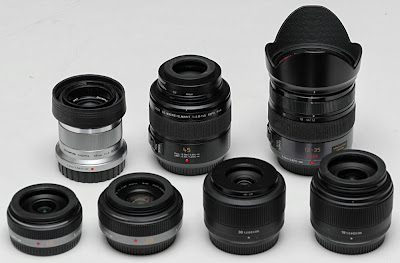This time, I want to look more closely at how the bokeh differs by lenses. I've tested some common fast lenses from the Micro Four Thirds lens lineup, laid out here:

Second row: Olympus 45mm f/1.8, Leica Lumix 45mm f/2.8 macro, Lumix X 12-35mm f/2.8
First row: Lumix G 14mm f/2.5, Lumix G 20mm f/1.7, Sigma 30mm f/2.8 DN and Sigma 19mm f/2.8 DN
I also tested the Lumix Leica DG Summilux 25mm f/1.4 and Lumix X 35-100mm f2.8, not pictured above.
Most of these lenses have my alternative hood solutions on this picture.
To test the lenses, I used a night scene with some bright out of focus highlighs in the background. The focus was set on the steel arch in the foreground. This type of scenes tend to bring out any weaknesses in the bokeh, and is useful for testing.
Panasonic lenses
Lumix X 12-35mm f/2.8
This is a high end standard zoom lens, corresponding to a typical photojournalist normal zoom lens. It is fairly expensive, and has a very good image quality, fast focus, and is a pleasure to use.
At 12mm:
 |  |
| The whole scene | A 100% crop from the upper left part |
At 25mm:
 |  |
| The whole scene | A 100% crop from the upper left part |
At 35mm:
 |  |
| The whole scene | A 100% crop from the upper left part |
This lens has nice looking bokeh, but it can be a bit "dirty" in the sense that the out of focus highlights are not uniformly lit, but have some irregular texture. Also, the out of focus highlights can be non-round towards the edges of the frame.
There is some flare in the picture, quite common for a complicated lens like this, with many lens surfaces in the optical construction. Even with a good anti reflective coating, some reflections still arise, lessening the contrast and adding flare.
Lumix G 14mm f/2.5
The smallest Micro Four Thirds lens, it receives mixed reviews. I think it is much better than its reputation, which tends to be a bit poor due to this lens being sold off cheaply from splitting camera/lens kits. In fact, I think it is a very good lens, with fast and silent autofocus.
 |  |
| The whole scene | A 100% crop from the upper left part |
Since this is a wide lens with a moderately large aperture, you don't get much out of focus rendering, even when focusing fairly close like in this example. However, we see that the bokeh is quite good looking. It exhibits slightly elliptical shapes towards the edges of the frame, just like the two following Panasonic lenses.
Here is another example image from the Lumix G 14mm f/2.5 lens wide open. You must focus quite close to get any significant selective focus effect:

Lumix G 20mm f/1.7
This lens became an instant classic, after being released in 2009 as the very first Panasonic prime lens for Micro Four Thirds. It is loved for the very sharp images, fast aperture, and compact size. On the negative side, it has quite slow autofocus, and the focus can be a bit noisy. It is not well suited for video, if you want to use the autofocus during video recording.
 |  |
| The whole scene | A 100% crop from the upper left part |
The bokeh here is good looking, with the exception of being far from circular towards the edges, a common problem with Panasonic prime lenses. Also, the image exhibits some flare, and it could have handled the contrast slightly better, I think.
In this article, (scroll down about 1/3) you can see example images taken with this lens at f/1.7-f/16.
Here is another example image taken at f/1.7, at a fairly close focus distance:

Lumix Leica DG Summilux 25mm f/1.4
This is Panasonic's take on the classic fast normal lens. It is Leica co-branded, indicating a high quality, and also a high price tag.
 | |
| The whole scene at maximum aperture, f/1.4 | A 100% crop from the upper left part |
We see that just like many of the other Panasonic lenses, the out of focus highlights are non-round outside the centre, especially in the corners. Beyond that, though, the bokeh looks fine.
Here are some other examples. All these images were taken at f/1.4.
Focus distance about 1 meter:
In the following picture, I focused on the seagull in the foreground, with a focus distance of about 1.5 meters:
The background is not blurred very nicely. It is quite busy, with some ringing around the highlights. Here is a crop from the upper left corner which shows this:
I am disappointed to see that the bokeh for this premium lens is not very good. The out of focus highlights are non-round in the corners, and when focusing on medium close subjects, the background can be quite busy. Otherwise, in terms of sharpness, it is certainly a very good lens.
Leica Lumix 45mm f/2.8 macro
A fairly expensive lens, usable both for portraits, and for macro. It has very good image quality, but the focus can be slow. Uncommon for a prime lens, it features optical image stabilization (OIS).
 |  |
| The whole scene | A 100% crop from the upper left part |
Again, just like the other two Panasonic prime lenses, we see some very elliptical shapes towards the edges. This can be a big problem, in my experience. Here is another example image which illustrates the elliptical shapes:

When stopped down, the bokeh is still quite rounded. See an example at this link (scroll down a bit).
Lumix X 35-100mm f/2.8
This is Panasonic's take on the classic photojournalist's tele zoom, and can also be called a portrait zoom. It is a high end lens, one of the most expensive among the M4/3 lens lineup. It is considered to be very sharp, and is held in high regard.
I don't have this lens myself, but I was able to borrow it in a photo shop. Here are two images showing the bokeh quality of the lens. Both images were taken at f/2.8, focused as close as possible (0.85m).
 |  |
| Lumix X 35-100mm f/2.8 @ 35mm | Lumix X 35-100mm f/2.8 @ 100mm |
In the images, we see very clearly that even this lens, at this time the most expensive Panasonic lens, suffers from the elliptical blurred highlights outside of the image centre. This also goes for highlights that are closer than the focus distance, see the image taken at 35mm.
"Elliptical" is perhaps not the correct geometric description. It looks more like a shape formed by clipping a disc with a circle, as if the front lens element is not sufficiently large to cover the entire image frame.
This is probably no big issue if you are photographing in low contrast situations, e.g., during daytime. However, with big contrasts in the background, the bokeh can look a bit distracting.
Olympus lenses
Olympus 45mm f/1.8
The first true portrait lens for Micro Four Thirds, it is reasonably priced, has good image quality, and focuses quickly. The image quality is not the best wide open, but it is quite good when stopped down to f/2.8.
 |  |
| The whole scene | A 100% crop from the upper left part |
The bokeh here is very good. It is round, has an even tone. Near the edges, you can see that it is slightly non-circular. When stopped down, the bokeh becomes a bit jagged. See an example at this link (scroll down a bit).
Here is another example image, also taken at f/1.8:

Typical for Olympus, the out of focus highlights have a very sharp edge. This some times makes autofocus difficult: Since the out of focus highlights are so sharp, the camera can think that the image is in fact in focus, and leave it at that. I've experienced this problem many times when taking pictures at night time: The camera thinks the bokeh is the subject, and doesn't focus right.
The property of hard bokeh edges is also shared with the Olympus 50mm f/2 macro (Four Thirds lens).
Sigma lenses
Sigma 19mm f/2.8 DN
It doesn't have as good sharpness as the Lumix G 20mm f/1.7, but it is less expensive, and focuses faster.
 |  |
| The whole scene | A 100% crop from the upper left part |
Compared with the Lumix G 20mm f/1.7, the Sigma 19mm has much better looking bokeh. It is rounded, has an even texture. Also, the lens appears to handle the flare better, and has very good contrast.
I've found that the Sigma 19mm lens has slightly worse sharpness (see here for a test), but beyond that, the Sigma 19mm is better in most respects.
Here is an example image taken at f/2.8. The focus was set to the rose in the lower left corner:

The bokeh is generally very nice, however, there is a bit of ringing in the top right corner.
Sigma 30mm f/2.8 DN
A prime lens with overall very good image quality, and fast autofocus.
 |  |
| The whole scene | A 100% crop from the upper left part |
Again, just like the 19mm lens, this one has very nice bokeh. I think it also renders with a nice clarity, handling the flare and contrast well.
Here is another example image taken at the shortest focus distance, and with the aperture wide open at f/2.8:

The bokeh looks very creamy and smooth.
Sigma also have the Sigma 60mm DN. I haven't tried it, but based on what I have read and seen, it too has a very good sharpness, and nice bokeh.
Conclusion
Panasonic lenses tend to exhibit non round out of focus highlights outside the centre. This is especially a problem for the Leica Lumix 45mm f/2.8 macro and the Lumix G 20mm f/1.7. In daytime, this can be no problem at all, but at night, it can be a bit distracting. In my experience, it can help to stop down the aperture a bit, which makes the highlights less elliptical.
It is perhaps a surprise that the Sigma lenses perform the best here, given that they are the cheapest. On the other hand, these lenses are in a way the less ambitious: They don't try to be compact (pancake lenses), to be very wide, or to be very fast (in terms of aperture). This makes it easier for Sigma to make them excel in terms of optical performance. So for the best optical performance at a low price, get the Sigma lenses, especially the Sigma 30mm f/2.8 DN.
For the best overall performance, I would say the Lumix X 12-35mm f/2.8 is the lens to go for. Then again, it is also the most expensive of the bunch.
Thanks you for the bokeh review.
ReplyDeleteHow about Leica 25mm bokeh?
I can't answer that, since I don't have the Leica 25mm f/1.4 lens available. However, I will probably be able to answer it within a couple of weeks time.
DeleteThank for your reply.
DeleteI have tested the Leica 25mm lens now, and included the results above. Sadly, it is not the best lens in terms of bokeh.
DeleteI wonder 35-100mm also suffer from the elliptical bokeh?
ReplyDeleteBased on some example images I have seen on the web, it is clear to me that it does, at least at f/2.8 and certain focal lengths.
DeleteI just tested this lens, and can confirm that it also has the elliptical bokehs. See the images in the article above.
DeleteYou forgot to mention that the Sigma DN lenses have a larger image circle, so you weren't actually testing their bokeh near their 'true' edges.
ReplyDeleteBut generally a useful article for me, thanks.
The crop of the seagull pic shows massive camera shake? Look at the steps, they're all double imaged.
ReplyDeleteNo, there is no camera shake in the seagull picture. The double image in the background is due to bokeh ringing, a common issue with large aperture lenses.
DeleteThe picture was taken with a shutter speed of 1/800s, so camera shake is simply not possible.
I find the bokeh of the Panasonic to be beautiful, especially the 25 and 45mm. I find the bokeh almost as a drawing with these lenses. I agree that your sample with the 25mm was not the best, but this is not typical for the lens. I also do not mind the elleptical bokeh, it is probably like that on design.
ReplyDeleteI think the elliptical out of focus highlights are more a problem with high contrast night time photography. With lower contrast, this is barely noticeable.
DeleteUseful and unique article, as always.
ReplyDelete